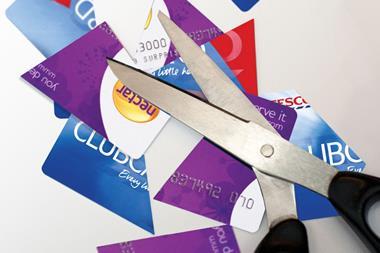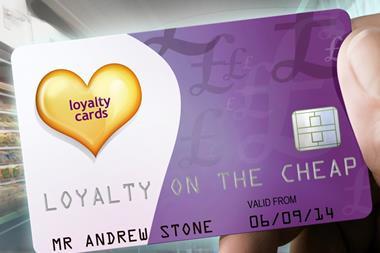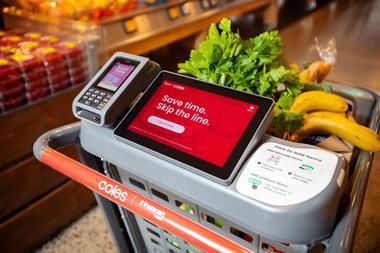I shall be destroying my Nectar Card and I won’t be doing any more shopping with Sainsbury’s,” blasted one outraged punter on thegrocer.co.uk earlier this week, after Sainsbury’s halved the number of Nectar points it gives away with every purchase. “I think we’ll be switching to Lidl,” snarked another.
The comments offered proof, if any were needed, that this is not a grocery market where offering customers less will see them flood through the doors. They offered less evidence over the future of the loyalty card, however. While they suggest customers still care about them, they also reveal a craving for simple pricing instead. So is the loyalty card still a potent weapon? Or is investing in price the best way to spend a few hundred million quid?
As Clubcard’s daddy, it’s no surprise Tesco appears to remain confident in its progeny. Indeed, when it comes to the debate over the future of loyalty cards, Clubcard is arguably the best-ever example of a quasi-promotional mechanic boosting the fortunes of the retailer behind it. However, Shore Capital’s Clive Black says that though Clubcard was “clearly a quite incredible dynamic that helped transform the business”, it “wasn’t in isolation” and corresponded with a “series of industry leading initiatives that complemented each other.”
Pure pricing
“Several iterations on, Clubcard is clearly not as potent as it used to be,” he adds. “If it was, Tesco wouldn’t be reporting heavily reduced like-for-like sales.
“Nectar has lost some of its potency as well. Loyalty cards are a much less effective driver of footfall in a time when pure prices, availability, checkout services, counter services and promotions are more effective.”
Not that he believes Tesco should dump Clubcard altogether. “It just needs to be re-engineered, which is what Sainsbury’s is trying to do.”
Sainsbury’s insists it will be doling out the same number of points as before. And arguably its plans to give away more points for petrol and offer double points events at seasonal events like Christmas can be good ones. So perhaps it can blame woeful communication for re-launching the card so haphazardly.
In fact the only loyalty card that does seem to have created some traction is the myWaitrose loyalty card - perhaps the best example of what can be achieved with a bit of leftfield thinking. Giving away coffee and papers (an example of what MD Mark Price refers to as “the power of free”), plus discounts on selected products (that are redeemed instantly), has won it praise from industry and customers alike. And, according to Kantar Worldpanel, it has secured record market share of 5.2% and boosted sales by 6.8% over the year.
As to Morrisons, with its latecomer advantage, it should be the best of the lot. And it did bring some fresh thinking to the party: its claim to match the discounters on price addressed one of its biggest issues head-on.
However, Lidl quickly hit back with a cheeky riposte, which exposed its flaws and nailed what Black believes is promotional fatigue among shoppers.
“They are suspicious of everything but lower prices, so we look at Match & More with a degree of incredulity,” he says.
The data side of the card - and all the valuable insights they could bring to the Morrisons table - also remains a work in progress. So Morrisons is giving, but it isn’t yet taking.
Sleeping around
The belated entry of the Morrisons card also makes the whole concept a little weaker, argues BT’s head of consumer insight and futures Dr Nicola Millard. “Consumers have all the loyalty cards,” she says. “So are they loyal? It’s more like sleeping around.”
Sainsbury’s embattled CEO Mike Coupe used a similar analogy earlier this month, describing shoppers as “promiscuous”. “Whereas they may have had one or two choices of supermarket, they’ve now got four or five on their doorstep,” he said.
“Several iterations on, Clubcard is clearly not as potent as it was”
In this environment, the degree of loyalty a card can generate has to be challenged. The discounters certainly don’t have time for loyalty cards. As Aldi GMD Matthew Barnes told The Grocer last year: “Loyalty is driven by the fact when customers come to our stores they know what the price will be. We are the only EDLP retailer, that’s what drives loyalty. Not a piece of plastic to build points up on.”
It’s also worked for Lidl, and for Asda. Indeed, sales figures for the 12 weeks ending 12 October 2014 are not a great argument for Clubcard, Nectar, or Match & More.
Aldi and Lidl sales remain rampant, up 27.3% and 18.1% respectively, while Asda - the only big four retailer now without a loyalty card - has “again emerged as the winner among the big four, growing sales ahead of the market, up 1% over the past year, boosting its market share to 17.3%,” says Kantar’s head of retail and consumer insight Fraser McKevitt.
Asda would “rather spend the hundreds of millions of pounds Tesco dishes out on Clubcard, which rewards the people who can afford to spend the most, by lowering prices across the board for everyone. Unlike pointless plastic cards, our value is immediate and available to everyone, no questions asked.”
Meanwhile, over the same period, Kantar says Sainsbury’s and Morrisons’ sales fell 3.1% and 1.8% respectively, while Tesco sales are down 3.6%.
That makes the fight for loyalty more important than ever. But the supermarkets winning customers at the moment don’t have a loyalty card, or any plans to offer one. Instead, they use EDLP to win them round. So if an alternative to investing millions in a loyalty card is to use those millions to fund a lowering of prices instead, the way the market is shifting appears to offer a persuasive argument for the latter.
To put it another way: if loyalty cards are still a potent weapon, now might be a good time to start firing them.



















No comments yet